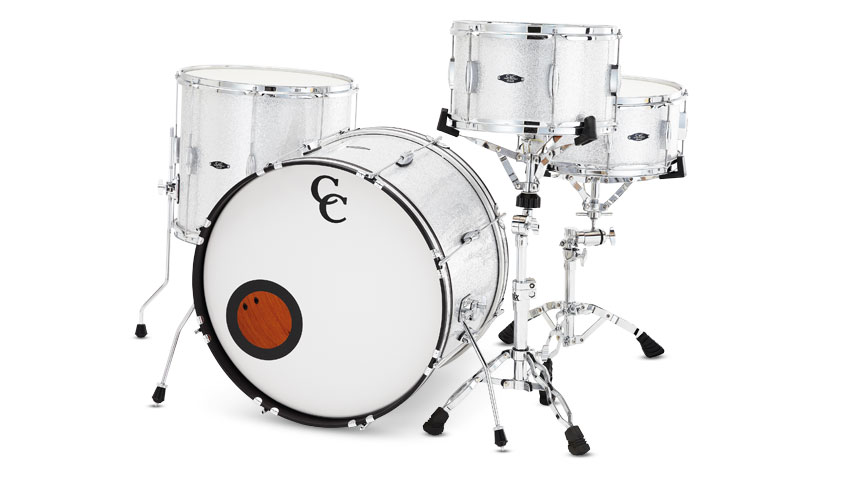MusicRadar Verdict
There is an unpretentious and honest feel to this kit that is appealing. The drums are based on uncomplicated designs, are well made from quality materials and sound utterly fantastic. The simplest of recipes can also be the tastiest.
Pros
- +
Simple, solid design and build. High quality materials and components. Wonderful sounds.
Cons
- -
Not much.
MusicRadar's got your back
Since its quiet inception over two decades ago, C&C Drum Company has remained determinedly low-key, operating on little more than a word-of-mouth basis. This four-piece Player Date on review is from C&C's first ever range of production (off-the-shelf) kits.
Based in Gladstone, Missouri and run by Bill Cardwell and his son Jacob, C&C (formerly C&C Custom Drums) has is known worldwide for building beautiful-looking and classic-sounding drums, but can its off-the-shelf kits maintain that reputation?
Build
If the Player Date bears any resemblance to Ludwig's Club Date kit reviewed a few issues ago, let's just say that Bill Cardwell had been developing his concept for some time before Ludwig - entirely coincidentally - had a similar idea.
"Much like C&C's company history, once Joey had taken delivery of his custom-built Player Date kit, word got out and everyone who encountered it wanted one"
The prototype of what would become the Player Date was built at the request of C&C endorsee Joey Waronker, who was seeking a kit that emulated a 1960s kit of Japanese origin.
Much like C&C's company history, once Joey had taken delivery of his kit, word got out and everyone who encountered it wanted one. After being deluged with orders, C&C decided to put it into production, marketing it as an intermediate range encapsulating the qualities of C&C drums.
Currently two shellpacks are available - Be-bop (20"x14", 12"x8", 14"x14" & 14"x51⁄2" snare) and the reviewed Big Beat (22"x14", 13"x8", 16"x14" and 14"x61⁄2" snare). Of the three finishes offered, two are lacquers (Amber and Honey); the third being the more expensive Silver Sparkle wrap seen here.
As with the kit that inspired them, Player Date drums are made from mahogany (albeit hand-built rather than mass produced). C&C double-ended Radio King Reissue lugs run around the centre of each drum shell with progressively longer tension rods radiating out from them with each increase in diameter and depth. On the larger drums they look a little exposed but in reality are deceptively strong.
Want all the hottest music and gear news, reviews, deals, features and more, direct to your inbox? Sign up here.
Hands On
The shells are straight-sided and are 6-ply/7mm thick across all of the drums, with the outer and inner plies running horizontally. On the snare and toms the bearing edges are described by C&C as full-contact. They are cut from the inner ply downwards in a smooth curve across to the outer ply.
C&C experimented with full-contact bearing edges on Player Date bass drums but decided on a more regular centrally-cut edge. This is still rounded over rather than being cut sharp, providing a large contact area.
"The full-contact bearing edges on the toms mean they generate virtually no overtones, so they can be played wide open and still sound in control"
The bass drum's vintage depth encourages a focused, almost abrupt response, walloping out a full, thick note. It's still deep and punchy but nowhere near as dark as a modern 'subwoofer-territory' kick. These qualities give it an unmistakable presence - especially when miking - that is achieved without resorting to sheer force.
Tuning the kick higher tightens up the sound without choking off its tone while slackening off the head brings a fruity, fat warmth to the proceedings that requires only the tiniest amount of dampening to shape.
The full-contact bearing edges on the toms mean they generate virtually no overtones, so they can be played wide open and still sound in control. They are phenomenally warm - think Motown warm - wonderfully resonant and full of woody character.
Fills bounce across the mix in the same way that toms on old recordings - compromised by primitive studio technology and smothered with layers of compression - seem to leap forth whenever they are hit. We tried tuning the toms at various pitches and each time they responded well; it was difficult, if not impossible, to extract a dull sound from them.
Clarity, shell timbre and yet more warmth are the dominant features of the snare. Here the bearing edges make the snare wires super-sensitive, giving the drum a really crisp tone. The simple 'beer tap' style throw-off is straightforward to operate and definitely subscribes to the 'less is more' school of design.
At the time of writing the only way of getting hold of a Player Date kit is direct from C&C's European distributor in Germany.
